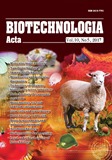IISSN 2410-7751 (Print)
ISSN 2410-776X (Online)

"Biotechnologia Acta" V. 10, No 5, 2017
https://doi.org/10.15407/biotech10.05.030
Р. 30-35, Bibliography 19, English
Universal Decimal Classification: 57.08:636:31
TECHNOLOGY OF STERLET REPRODUCTION BY MEANS OF CRYOPRESERVED SPERM
L.P. Dragan1, A.I. Mruk1, V.M. Golian2, L.P. Buchatsky1, 3
1Institute of Fisheries of National Academy of Agrarian Sciences, Kyiv. Ukraine
2Ltd. "Odesa Sturgeon Complex", Vylkove, Odesa region, Ukraine
3Kyiv Taras Shevchenko National University, Ukraine
The purpose of the work was to reproduce the sterlet of the Danube and Dnieper populations using cryopreserved sperm frozen in modified cryoprotective medium. Low-temperature cryopreservation of sterlet male reproductive cells was carried out in accordance with conventional procedures of cryobiology.
As a result of the performed work, it has been found that the applied cryoprotective environment, which includes methanol, enhances the cryoprotective effect and is technologically optimal for the process of the Danube and Dnieper populations of sterlet sperm storage. Fish sperm cells retained viability after defrosting; their ability to fertilize the eggs was restored. The results of the conducted studies indicate that, despite a certain decrease in the quality properties of sperm after freezing/defrosting, its ability to fertilize did not significantly decrease. Revived in this way larvae from two populations of sterlet were used to reproduce repairing brood stock under conditions of fish farming.
Such a method of sterlet sperm cryopreservation could be recommended for use at commercial enterprises with sturgeon fish commodity cultivation.
Keywords: sterlet, sperm, cryopreservation.
© Институт биохимии им. А. В. Палладина НАН Украины, 2017
References
1. Lesyuk M. I., Kontva O. Yu., Rovba E. A.,Slukvin A. M. Molecular genetic studies of sterlet producers (Acipenser ruthenus L.) Moleculyanaya i prikladnaya genetika. Мinsk, 2012, 13, 110–117. (In Belarus).
2. Dudu A., Georgescu S. E., Burcea A., Florencu I., Costahe M. Microsatelittes Variation in Sterlet Sturgeon, Acipenser ruthenus from the Lower Danube. Animal Science and Biotechnologies. 2013, 46 (1), 90–94.
3. Suquet M., Dreanno C., Fauvel C., Cosson J., Billard R. Cryopreservation of sperm in marine fish. Aquaculture Res. 2000, V. 31, P. 231–243. 4. Belous A. M., Grishenko V. I., Parashuk Yu. S. Cryopreservation of reproductive cells. K.:Naukova dumka. 1986, 208 p. (In Ukrainian).
5. Tsvetkova L. I. Methodical manual on cryopreservation of sperm of carp, salmon and sturgeon species of fish. M. VNIIPRKH, 1997, 11 p. (In Russian).
6. Sudakova N. V. Technologies and standards for commodity sturgeon breeding in the VI fishbreeding zone. Moskva: VNIRO, 2006, 100 p. (In Russian).
7. Filipov V. Yu., Mruk A. I., Drahan L. P., Haloian L. L., Buchatskyi L P. Evaluating efficiency for the implementation of the cryopreservation components of (Salmo trutta morfa fario Linne) sperm. Rybohospodarska nauka Ukraine. 2015, 1, 88–95. (In Ukrainian).
8. Chabanov M. C., Galich E. V., Chmur Yu. M. Guide to breeding and growing sturgeon. Moskva: Rosinformagrotek, 2004. 135 p. (In Russian).
9. Kazakov R. B., Obraztsoy A. N. Methods for assessing the sexual cells of fish: fish-breeding evaluation of sperm. Obz. Inf. Ser. Varikultura, Marikultura VNIERKH. 1990, V. 4, 1–54 (In Russian).
10. Lunev G. E. Use of methyl alcohol for cryopreservation of sperm of Russian sturgeon. Materials of the 3rd scientificpractical. Conf. Astrakhan: CaspNIRKh, 2009, 131–132. (In Russian).
11. Kononenko I. S., Pugovkin A. Yu., Kononenko R. V., Cherepnin V. O., Butsky K. I., Kopeika E. F. Optimization of cryopreservation conditions of spermatozoa (Acipenser ruthenus L. 1758) for fertilization of spawn in fish farms). Rybogospodarska nauka Ukraine. 2017, V. 3, P. 83–97. (In Ukrainian).
12. Detlaf T. A., Ginzburg A. S., Shmalhausen O. I. Development of sturgeon fishes. (Egg maturation, fertilization, development of embryos and pre-larvae). Moskva: Nauka, 1981. 224 p. (In Russian).
13. Boryshpolets S. P., Dzyuba B. B. Use of Methanol For Cryopreservation of Sperm of Different Fish Species. Problems of Crybiolgy. 2008, 18 (2), 224.
14. Sadeghi A. Cryopreservation of stellate (Acipenser stellatus) sperm: Effect of different concentrations of DMSO and dilution dates on sperm mobility and motility duration after longterm storage. Global Veterinaria. 2013, V. 10, P. 26–30.
15. Shaliutina-Kole?ova A., Cosson J., Lebeda I. Gazo I., Shaliutina O., Dzyuba D., Linhart L. The influence of cryoprotectants on sturgeon (Acipenser ruthenus) sperm quality, DNA integrity, antioxidant responses, and resistance to oxidative stress. Anim. Reprod. Sci. 2015, V. 156, P. 66–76. https://doi.org/10.1016/j.anireprosci.2015.05.014
16. Nauk V. A. The structure and function of spermatozoa of agricultural animals in cryopreservation. Kishinev: Shtiintsa. 1991, 200 p. (In Moldova).
17. Kruglyak A. P. Forecasting cold resistance of semen of bulls on biochemical indicators Nauk. proizv. Conf. “New methods of breeding and biotechnology in animal husbandry”.Kyiv, 1991. 29–30 (In Ukrainian).
18. Samartsev V. N, Zeldi I. P. The participation of SH-groups in the regulation of malate oxidative phosphorylation and palmated respiratory depression in liver mmitochondria. Biochimiya. 1995. 60 (4), 635–643. (In Russian).
19. Beirao J., Cabrita E. Effect of cryopreservation on fish sperm subpopulations. Cryobiology. 2011. V. 62, P. 22–31. https://doi.org/10.1016/j.cryobiol.2010.11.005

